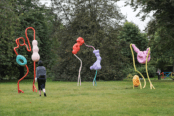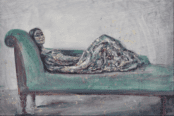[dropcap style=”font-size:100px; color:#992211;”]I[/dropcap]n 1969 the old-Etonian writer, antiquarian and ley-hunter, John Michell, published The View Over Atlantis.
A book that would pretty much invent Earth Mysteries.
The ley-line wasn’t new. Alfred Watkins ‘discovered’ it back in the 1920s when he had a vision of the landscape criss-crossed by ancient trackways. He spent much of his later life searching for straight alignments between the wells, churches, standing stones, nooks in the skyline, and so on that he thought had been waymarks on these prehistoric paths.[quote]Just as acupuncturists
redirect chi through the
meridians of the body, so
Michell thought the ancients
channelled dragon energy by
erecting stones, building wells
and raising mounds at
auspicious, sacred sites[/quote]
Michell went a step further. He took Watkins’ alignments and fused them with ideas from Chinese geomancy such that leys were now conduits of earth or dragon energy. Just as acupuncturists redirect chi through the meridians of the body, so Michell thought the ancients channelled dragon energy by erecting stones, building wells and raising mounds at auspicious, sacred sites. These nodes were distributed across the land according to the principles of number, proportion and sacred geometry.
Dragon Energy
Correct use of dragon energy led to bountiful harvests and harmony between humankind and nature. Indeed, the gradual attrition of this knowledge was what had caused our current ecological crisis: its recovery would enable our salvation.
Michell’s most famous discovery was the St Michael line. He noticed that two Somerset churches dedicated to St Michael – Glastonbury Tor and the wonderfully named Burrow Mump – had not only been situated on distinctive conical tors, both of which rise up dramatically from the Somerset levels, but were also aligned precisely to the Mayday sunrise (27 degrees north of East). 
When he drew a line between them, and extended it in both directions, he found to his astonishment that it passed through sacred sites like Avebury in Wiltshire, the Hurlers and the Cheesewring in Cornwall, and also through a disproportionately high number of churches dedicated to St Michael, including St Michael’s Mount.
St Michael is known for his war with satan and is often depicted standing triumphant over a fallen dragon. Could it be that he was a Christianised Sun god and that here was an ancient ley, a dragon path, but one that had been gradually suppressed by a Church hostile to paganism?
Then in the eighties two dowsers, Hamish Miller and Paul Broadhurst, set out to dowse the currents of dragon energy all the way up the Michael line. They published their results in The Sun and the Serpent. What they found was that the earth energy meandered about Michell’s ley-line like a serpent on a Caduceus. Or rather, like two serpents up a Caduceus for they discovered a second energy current that they called the Mary line, the feminine counterpart to the masculine Michael line.
Now it turns out that there’s a group working to create a long distance footpath along the Michael and Mary lines, all the way from the tip of Cornwall to the coast of Norfolk. They’ve already opened a trial section from Brent Tor to Glastonbury, presumably using existing footpaths, and have published two guidebooks. The route passes pretty close to the village where I live.
It’s not hard to find fault with the concept of ley-lines. Britain is so pock-marked with ancient sites that if you dropped a line down at random you’d be hard-pressed not to find something of significance along its course. We have what the ancients did not – maps – that afford us a God-like aerial view and allow us to plot lines and angles unappreciated from the ground. And isn’t dowsing just a process of wish-fulfilment?
Well, here I’m prepared to keep an open mind. For, if nothing else, I love the idea of dragon energy spiralling through the land as a metaphor for the spirit of place. I prefer my landscape enchanted, thank you very much.
And as I maintain that the best way to know the land is to walk the land, to feel its rising and falling beneath the feet, or as Robin Williamson puts it, to tread ‘the hard mile after the easy mile’ (assuming of course this option is available to you), I fully support this new venture.
Long Distance Trails
For it doesn’t really matter whether earth energy or the Michael line exist or not. Here on Dartmoor there are a number of long distance trails. Some have legendary or semi-historical origins, such as the the Mariner’s Way and the Abbot’s Way; others like the Two Moors Way, the Dartmoor Way, and the Taw-Teign link are purely modern, secular creations.
But once a route is created it opens not so much a physical connection between places, which was there anyway, but a mental connection. We experience Glastonbury Tor, say, in a different way when we know we could, by simply following a straight line, walk to Avebury in one direction or St Michael’s Mount in the other. The landscape becomes not so much a succession of different places but a connected whole.
At a time when many of us experience a profound sense of disconnection or even alienation from the land, we need more modern pilgrimages like this. And if we summon up the dragon as we go, so much the better.
A writer and a folk musician, Andy is the author of ‘Shroom: A Cultural History of the Magic Mushroom’ and has published a range of articles and academic papers on subjects as diverse as psychedelics, paganism, bardism, environmental protest, fairies, shamanism and evolution. A modern day troubadour, he plays mandolin, writes songs, and fronts darkly crafted folk band, Telling the Bees. A leading exponent of the English Bagpipes, he plays for brythonic dancing in a trio called Wod.



















